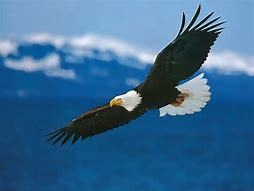BIRD OF THE MONTH: BALD EAGLE
The Bald Eagle has been the national emblem of the United States since 1782 and a spiritual symbol for native people for far longer than that. In 1978 the bird was listed for protection under the Endangered Species Act and has since made a remarkable recovery. It was removed from the endangered list in 2007 and has continued to thrive although it is still threatened by environmental pollution, poisoning from hunting ammunition, collisions with motor vehicles and stationary structures and destruction of nesting habitat.
This bird stands at 31" tall with a wing span of over 6 feet. Its gleaming white-feathered head contrasts sharply with its rich chocolate-brown body thus earning the title of "bald".
The Bald Eagle is a powerful flier and is able to soar long distances. It is also able to swim using its wings to mimic a motion similar to the butterfly stroke.
Typically, the Bald Eagle nests in a forested area near a large body of water. It builds one of the largest of all bird nests using sticks and branches and averaging 5 to 6 feet in diameter and 2 to 4 feet tall. The largest Bald Eagle nest on record was found in St. Petersburg, Florida. It measured about 9 feet wide and 18 feet tall.
The Bald Eagle mates for life. In one of the more spectacular courtship displays, a male and female fly high into the sky, lock talons and cartwheel downward together, breaking off at the last instant to avoid crashing to earth.
Usually, two eggs are laid. Both mom and dad incubate the eggs and both parents care for the young after they hatch. While the eggs are in the nest, the parents are very careful around them even clenching their toes to prevent the eggs from being punctured by their talons.
The eaglets hatch in 35 - 46 days and will leave the nest in 10 - 11 weeks. Mom and dad will still feed them for about a month after fledging. Gradually the young eagles will spend more and more time away from their parents and learn to hunt by trial and error.
The Bald Eagle usually prefers to eat fresh fish but will also eat birds, mammals and carrion. It will hunt from a high perch gliding down to catch its prey or wade into shallow streams or rivers for fish. This bird will also snatch prey from other creatures such as harassing an osprey until it drops its catch in midair and swooping it up. It will even snatch a fish directly out of an osprey's talons!.
Sometimes even the national bird has to cut loose. Bald Eagles have been known to play with plastic bottles and other objects. A pair was once seen passing sticks to each other in midair.
An immature Bald Eagle will spend the first four years of its life exploring vast territories and can fly hundreds of miles in a day. Young birds from Florida have been found in Michigan and birds from California have reached Alaska.
Bald Eagles can live a long time with a longevity record of 38 years in the wild.
As you may know, Benjamin Franklin was not a fan of the Bald Eagle. In 1784, he said, "I wish the Bald Eagle had not been chosen the Representative of our Country. He is a Bird of bad moral Character. He does not get his living honestly........Besides he is a rank Coward."


